Abstract
Twenty-four-hour metabolic profiles were performed twice in each of 15 diabetic children, once when they were receiving single daily injections of insulin (Monotard plus Actrapid) and once on a twice-daily regimen (Semitard plus Actrapid). Before the study control was optimised at home on each regimen. There were no differences in overall 24-hour diabetic control on the two regimens as measured by mean blood glucose concentration, area under the blood glucose curve, M value, and 24-hour urinary glucose excretion. Hyperglycaemia after breakfast occurred on both regimens. Significant differences were noted before breakfast, when blood glucose and ketone concentrations were lower and plasma free insulin higher on the single-injection regimen, and after supper and during the night, when blood glucose values were lower on the two-injection regimen and associated with a rise in plasma free insulin after the evening injection. Once-daily injections provided insufficient circulating insulin after the evening meal, while twice-daily injections did not last through the night. Plasma C peptide, indicating residual endogenous insulin secretion, was just detectable in two children but easily detectable in four children, whose 24-hour diabetic control was significantly better than that in the remaining 11 children.
Conclusions about the superiority of one insulin regimen over another must be based on specific differences in diabetic control. Both regimens studied achieved adequate control, and though neither provided physiological control specific modifications to the regimens could help to produce more normal profiles.
Full text
PDF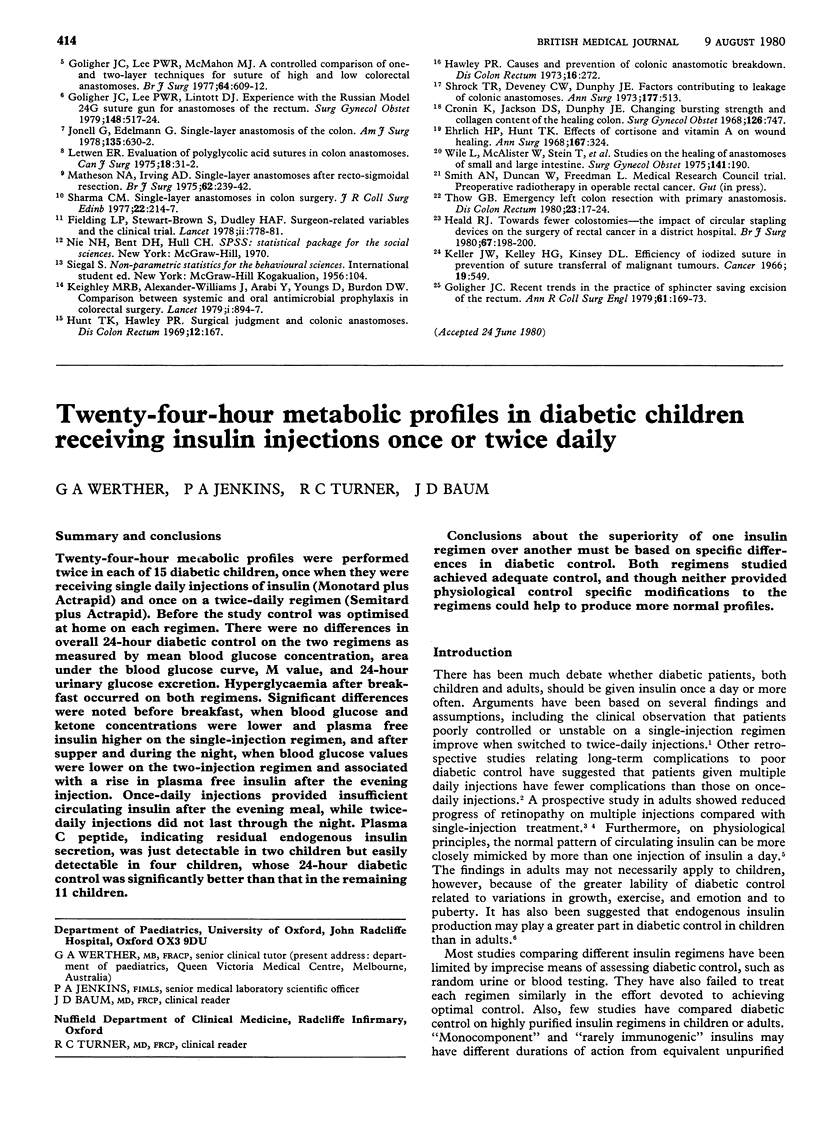
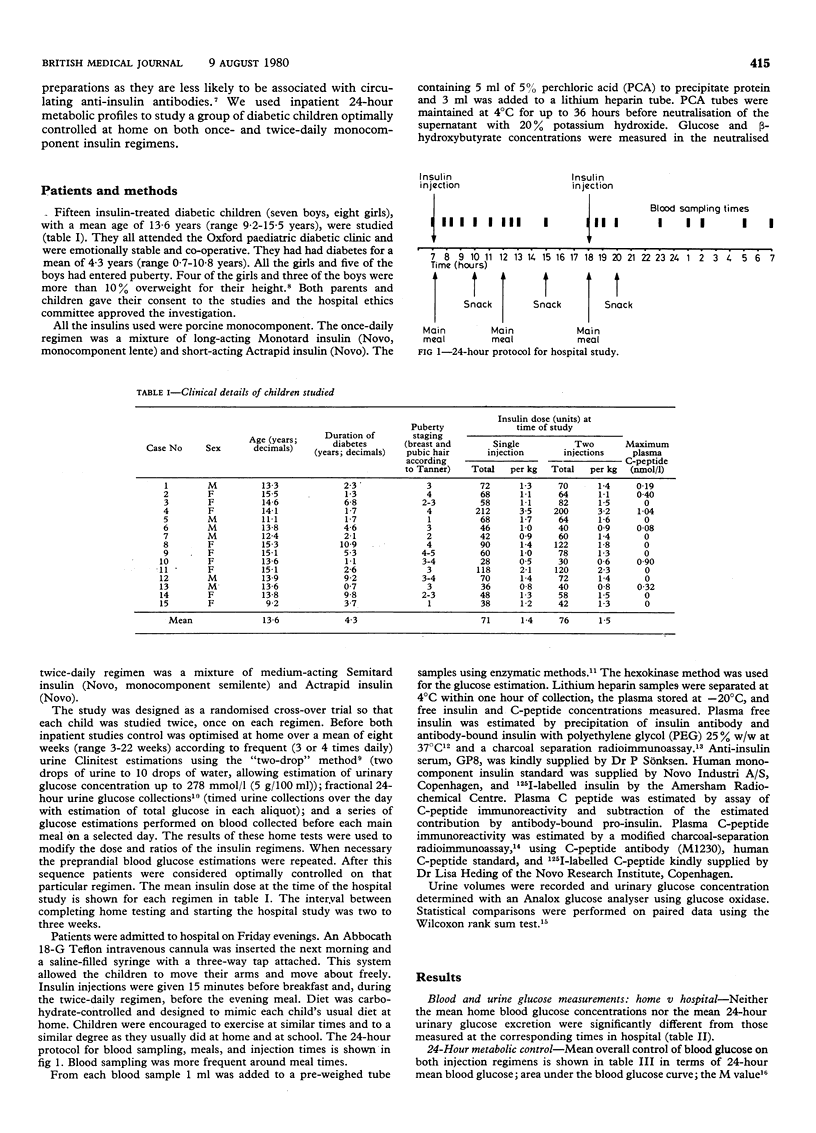
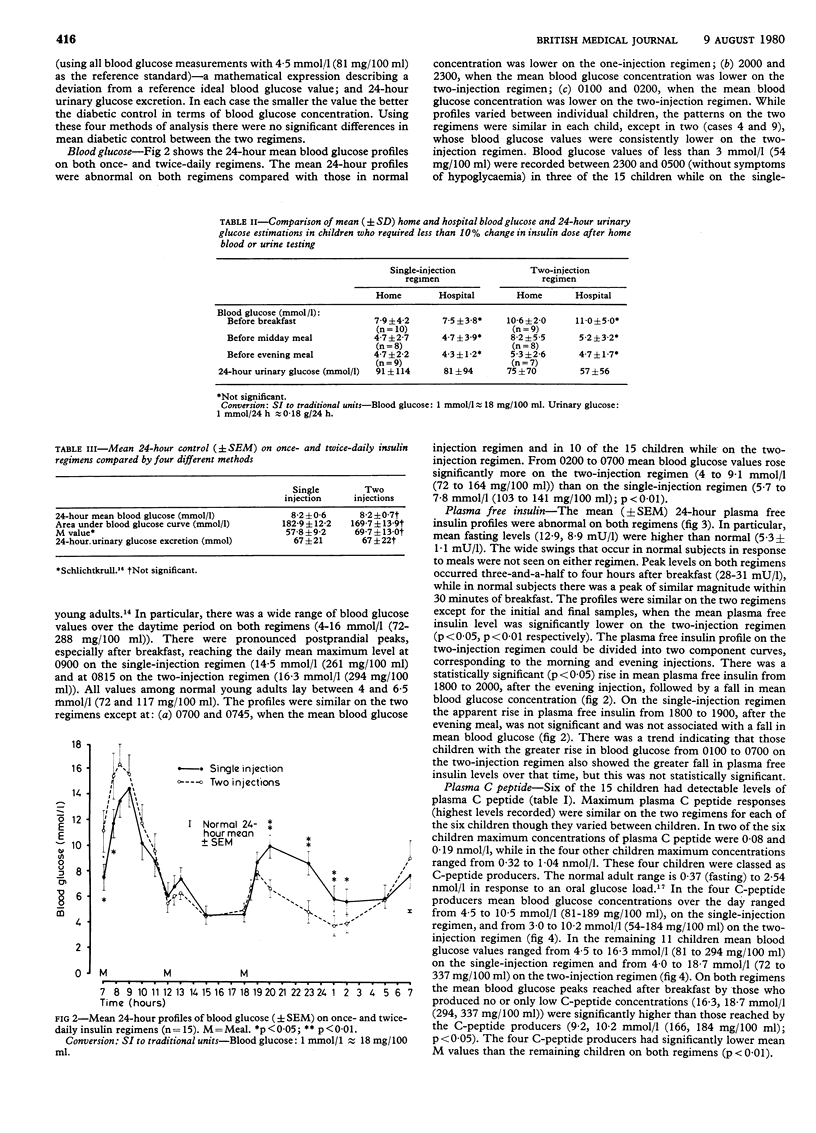
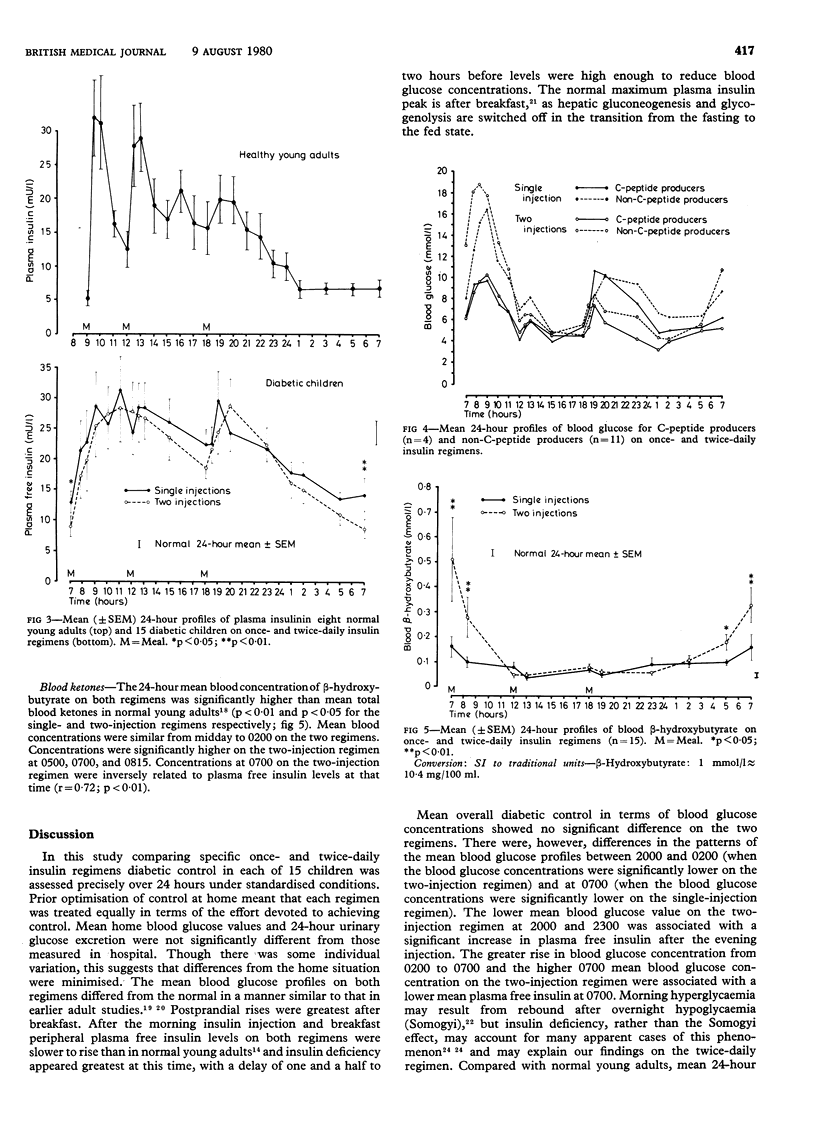
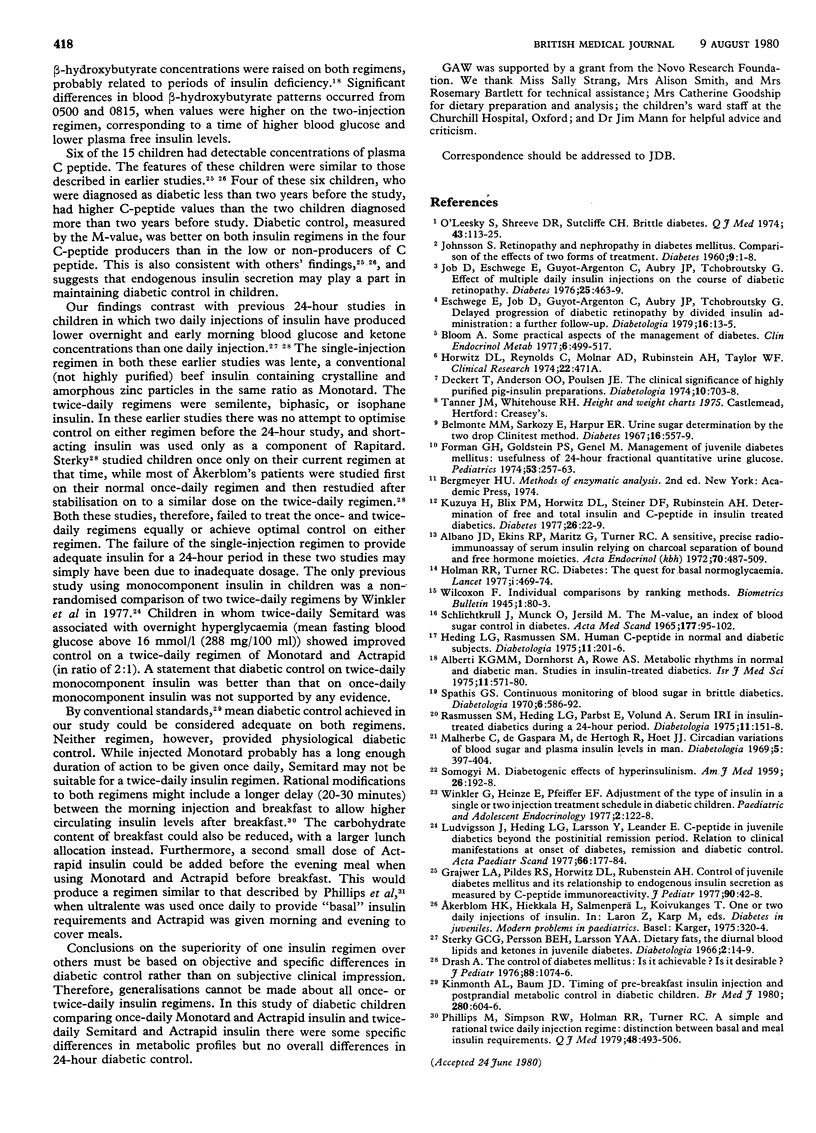
Selected References
These references are in PubMed. This may not be the complete list of references from this article.
- Albano J. D., Ekins R. P., Maritz G., Turner R. C. A sensitive, precise radioimmunoassay of serum insulin relying on charcoal separation of bound and free hormone moieties. Acta Endocrinol (Copenh) 1972 Jul;70(3):487–509. doi: 10.1530/acta.0.0700487. [DOI] [PubMed] [Google Scholar]
- Alberti K. G., Dornhorst A., Rowe A. S. Metabolic rhythms in normal and diabetic man. Studies in insulin-treated diabetes. Isr J Med Sci. 1975 Jun;11(6):571–580. [PubMed] [Google Scholar]
- Bloom A. Some practical aspects of the management of diabetes. Clin Endocrinol Metab. 1977 Jul;6(2):499–517. doi: 10.1016/s0300-595x(77)80049-2. [DOI] [PubMed] [Google Scholar]
- Deckert T., Andersen O. O., Poulsen J. E. The clinical significance of highly purified pig-insulin preparations. Diabetologia. 1974 Dec;10(6):703–708. doi: 10.1007/BF01219531. [DOI] [PubMed] [Google Scholar]
- Drash A. The control of diabetes mellitus: is it achievable? Is it desirable? J Pediatr. 1976 Jun;88(6):1074–1076. doi: 10.1016/s0022-3476(76)81104-3. [DOI] [PubMed] [Google Scholar]
- Eschwege E., Guyot-Argenton C., Aubry J. P., Tchobroutsky G. Effect of multiple daily insulin injections on the course of diabetic retinopathy. Diabetes. 1976 May;25(5):463–469. [PubMed] [Google Scholar]
- Eschwege E., Job D., Guyot-Argenton C., Aubry J. P., Tchobroutsky G. Delayed progression of diabetic retinopathy by divided insulin administration: a further follow-up. Diabetologia. 1979 Jan;16(1):13–15. doi: 10.1007/BF00423144. [DOI] [PubMed] [Google Scholar]
- Forman B. H., Goldstein P. S., Genel M. Management of juvenile diabetes mellitus: usefulness of 24-hour fractional quantitative urine glucose. Pediatrics. 1974 Feb;53(2):257–263. [PubMed] [Google Scholar]
- Grajwer L. A., Pildes R. S., Horwitz D. L., Rubenstein A. H. Control of juvenile diabetes mellitus and its relationship to endogenous insulin secretion as measured by C-peptide immunoreactivity. J Pediatr. 1977 Jan;90(1):42–48. doi: 10.1016/s0022-3476(77)80762-2. [DOI] [PubMed] [Google Scholar]
- Heding L. G., Rasmussen S. M. Human C-peptide in normal and diabetic subjects. Diabetologia. 1975 Jun;11(3):201–206. doi: 10.1007/BF00422322. [DOI] [PubMed] [Google Scholar]
- Holman R. R., Turner R. C. Diabetes: The quest for basal normoglycaemia. Lancet. 1977 Feb 26;1(8009):469–474. doi: 10.1016/s0140-6736(77)91954-7. [DOI] [PubMed] [Google Scholar]
- JOHNSSON S. Retinopathy and nephropathy in diabetes mellitus: comparison of the effects of two forms of treatment. Diabetes. 1960 Jan-Feb;9:1–8. doi: 10.2337/diab.9.1.1. [DOI] [PubMed] [Google Scholar]
- Kinmonth A. L., Baum J. D. Timing of pre-breakfast insulin injection and postprandial metabolic control in diabetic children. Br Med J. 1980 Mar 1;280(6214):604–606. doi: 10.1136/bmj.280.6214.604. [DOI] [PMC free article] [PubMed] [Google Scholar]
- Kuzuya H., Blix P. M., Horwitz D. L., Steiner D. F., Rubenstein A. H. Determination of free and total insulin and C-peptide in insulin-treated diabetics. Diabetes. 1977 Jan;26(1):22–29. doi: 10.2337/diab.26.1.22. [DOI] [PubMed] [Google Scholar]
- Ludvigsson J., Heding L. G., Larsson Y., Leander E. C-peptide in juvenile diabetics beyond the postinitial remission period. Relation to clinical manifestations at onset of diabetes, remission and diabetic control. Acta Paediatr Scand. 1977 Mar;66(2):177–184. doi: 10.1111/j.1651-2227.1977.tb07830.x. [DOI] [PubMed] [Google Scholar]
- Malherbe C., De Gasparo M., De Hertogh R., Hoet J. J. Circadian variations of blood sugar and plasma insulin levels in man. Diabetologia. 1969 Dec;5(6):397–404. doi: 10.1007/BF00427978. [DOI] [PubMed] [Google Scholar]
- Oleesky S., Shreeve D. R., Sutcliffe C. H. Brittle diabetes. Q J Med. 1974 Jan;43(169):113–125. [PubMed] [Google Scholar]
- Phillips M., Simpson R. W., Holman R. R., Turner R. C. A simple and rational twice daily insulin regime. Distinction between basal and meal insulin requirements. Q J Med. 1979 Jul;48(191):493–506. [PubMed] [Google Scholar]
- Rasmussen S. M., Heding L. G., Parbst E., Volund A. Serum IRI in insulin-treated diabetics during a 24-hour period. Diabetologia. 1975 Apr;11(2):151–158. doi: 10.1007/BF00429840. [DOI] [PubMed] [Google Scholar]
- SCHLICHTKRULL J., MUNCK O., JERSILD M. THE M-VALVE, AN INDEX OF BLOOD-SUGAR CONTROL IN DIABETICS. Acta Med Scand. 1965 Jan;177:95–102. doi: 10.1111/j.0954-6820.1965.tb01810.x. [DOI] [PubMed] [Google Scholar]
- SOMOGYI M. Diabetogenic effect of hyperinsulinism. Am J Med. 1959 Feb;26(2):192–198. doi: 10.1016/0002-9343(59)90308-0. [DOI] [PubMed] [Google Scholar]
- Spathis G. S. Continuous monitoring of blood sugar in brittle diabetics. Diabetologia. 1970 Dec;6(6):586–592. doi: 10.1007/BF00418226. [DOI] [PubMed] [Google Scholar]
- Sterky G. C., Persson B. E., Larsson Y. A. Dietary fats, the diurnal blood lipids and ketones in juvenile diabetes. Diabetologia. 1966 Jun;2(1):14–19. doi: 10.1007/BF01106970. [DOI] [PubMed] [Google Scholar]


